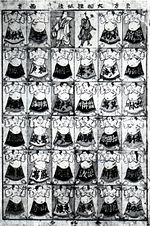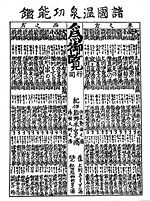Banzuke

Abanzuke(Phiên phó),officially calledbanzuke-hyō(Phiên phó biểu)is a document listing the rankings of professionalsumowrestlers published before each official tournament (honbasho). The term can also refer to the rankings themselves. The document is normally released about two weeks before the tournament begins.
On thebanzuke,wrestlers are divided into East, which is printed on the right, and West, which is printed on the left. Each wrestler's fullshikona(ring name), hometown and rank is also listed. The top of the page starts with the highest rankedmakuuchiwrestlers printed in the largest characters, down to the wrestlers in the lowestdivisionswhich are written in much smaller characters. The names ofgyōji(sumo referees),yobidashi(ushers/handymen),shimpan(judges),oyakata(elders of theJapan Sumo Association), and occasionallytokoyama(hairdressers) are also listed.
While not as old as sumo itself, the form and production of this document can be traced as far back as 1761, and has been a defining component of sumo for centuries. As is the traditional Japanese style, abanzukeis meant to be read right to left, top to bottom. It is considered a collector's item by sumo fans.[1]
Banzukepreparation[edit]


The rankings on thebanzukeare decided by an assembly composed of 20 sumo judges and three supervisors who gather a few days after each official tournament. The assembly assigns ranks to over 600 wrestlers in six divisions based on their performance in the previous tournament. There are no precise rules for assigning rank, but the general rule is that a wrestler who achievedkachi-koshi(a majority of wins) will be raised in the rankings and a wrestler with amake-koshi(a majority of losses) will be lowered in the rankings. The degree of a wrestler's success or failure will help give the assembly a benchmark for figuring how far he rises or falls in the rankings.[2]
High-rankinggyōjithen take on the laborious task of copying down the new rankings on a traditional Japanese paper roll called amaki.They carefully write down thekanjicharacters of each wrestler participating in a tournament in a calligraphy style calledsumomoji.The work is very intricate and requires a great deal of skill. It usually takes about a week to complete the document. Thebanzukeinformation is carefully guarded for several weeks before it is released, which is usually on the Monday 13 days before an official tournament begins.[2]The exception is the information about wrestlers who rise from the third divisionmakushitato the second divisionjuryo:their names become known immediately because they obtain the status ofsekitoriand have to make necessary preparations for it. Abanzukerelease may also be pushed back if the traditional publishing date falls on anational holiday.[3]
Thebanzukeis printed at a greatly reduced size on sheets of paper (58 cm x 44 cm) and copies are distributed by theJapan Sumo Association.Sumostablesbuy a large quantity of them to give to their sponsors. Tea houses in theTokyosumo venueKokugikanalso buy them to give out to their patrons. They are also available for purchase for a small fee at tournament sites.[1]
See also[edit]
References[edit]
- ^abHall, Mina. (1997).The Big Book of Sumo.Stone Bridge Press.ISBN1-880656-28-0.
- ^ab"How to Read a Banzuke?".Le Monde de sumo. 2004.Retrieved2007-11-24.
- ^"Grand Tournament Schedule".Japan Sumo Association. Archived fromthe originalon 20 April 2024.Retrieved29 April2024.Indicates the date of the May 2024 tournament'sbanzukerelease was on Tuesday 30 April, as Monday 29 April wasShōwa Day.
